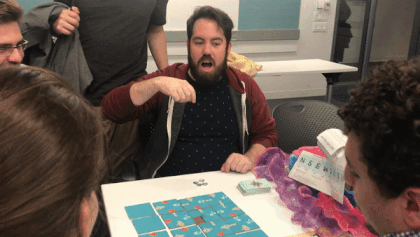

Don't Stop Breathin' is a puzzle game for two to five players. Players are a group of explorers looking for a treasure in the deep sea. There are two type of explorers: the Diver and the Navigators. Every turn one person takes a turn as the Diver holding their breath for as long as they can. That is the timer for the Navigators to perform actions on that turn. The goal of the players is to successfully move the tiles and create the full chest image before they run out of action cards.
Gameplay
The game starts with the Diver holding their breath and revealing three cards from the action deck. The Navigators discuss and make a fast decision about their moves.
The possible actions are:
- Moving all tiles on column or row (To East, West, North or South)
- Rotating all tiles on a column or row 90 degrees to any side
There are several special actions in the deck. These are:
- Rotating only one tile 90 degrees to any side
- Flipping one tile upside down
- Swapping two tiles
All the cards that were not used for that turn goes to the Discard Pile and never go back into the game. The game is over when the players run out of cards.
To end the turn properly, the Navigators need to touch on the Diver's shoulder to indicate they are done. If the Diver breaths before they are being touched, then the team loses one health.
The team starts with 5 health points. They can go up to 7. If they go down to 0, they lose the game.
As they move the tiles to match the pieces of the chest, there are three additional elements on the tiles that can be matched:
- Shells give the team +1 Health
- Sharks give the team 1 Damage (or -1 Health)
- Bubbles give the team one bubble token to be used at any time. With the bubble token, players can save cards to be used later and swiped into Discard Pile at the end of the turn.
Problem
Our initial challenge was to make a tile based game with a novel gameplay mechanic.
Solution
After trying out numerous different tile based games, we came up with a rubrics cube style puzzle mechanic that had an interesting gameplay experience using a tile system.
As we playtested our first prototype, our users expressed that the mechanic felt pretty novel. Hence, we fulfilled both our goals with this prototype.
Initial Prototype
In this version, each player was dealt 5 cards from the deck. And they were taking turn to play one card. Shells and Sharks were functioning the same way. However, Bubbles had a different effect in this prototype. In order to draw more cards, players had to match bubble tiles and when they do, everyone gets to draw a card.


Challenges
Even though our players like the core gameplay, they expressed some reoccurring concerns:
1. Dominant Players: Some players were too dominant and were making all the decisions
2. Too Many Options: Players were overwhelmed with the number of possible decisions ahead. As a result, they were spending a lot of time on deciding their actions.
3. Easy To Lose: Players were losing easily and the game felt way too punishing.
4. No Shortcuts: There was the lack of shortcuts to finish the game. Players felt stuck time to time.
Hence, we did several iterations on the game to solve these problems and improve the experience.
Iterations
Holding Breath As The Timer For Faster Decision Making
One of the main problems was players spending too much time and energy to decide on the perfect move for that turn. This problem led us to a very creative and unique solution where one of the players had to be the timer for that turn by holding their breath. This has became the hook of the game eventually.
Using A Common Pool Of Cards To Balance Player Dynamics
Another problem was some players' tendency to dominate other people's turns. We solved that with giving the players a common pool of cards. The navigators as a group decide which actions to do by discussing the available cards on that turn.
Special Action Cards As Shortcuts
There were cases where players were so close to winning but there were just no shortcuts to finish the game. Therefore, we added several special cards in the deck that they can use to do little adjustments to their strategy. These cards allows them to manipulate single tiles instead of the rows and columns.
Revealing Tiles During The Game For Lessening Options
As mentioned above, players were overwhelmed by the number of possibilities presented to them. Our solution was to let them start with only 4 tiles revealed and flip the rest of them as they continue playing. This change has both helped them to process informations, feel less overwhelmed and create a feeling of exploration.
